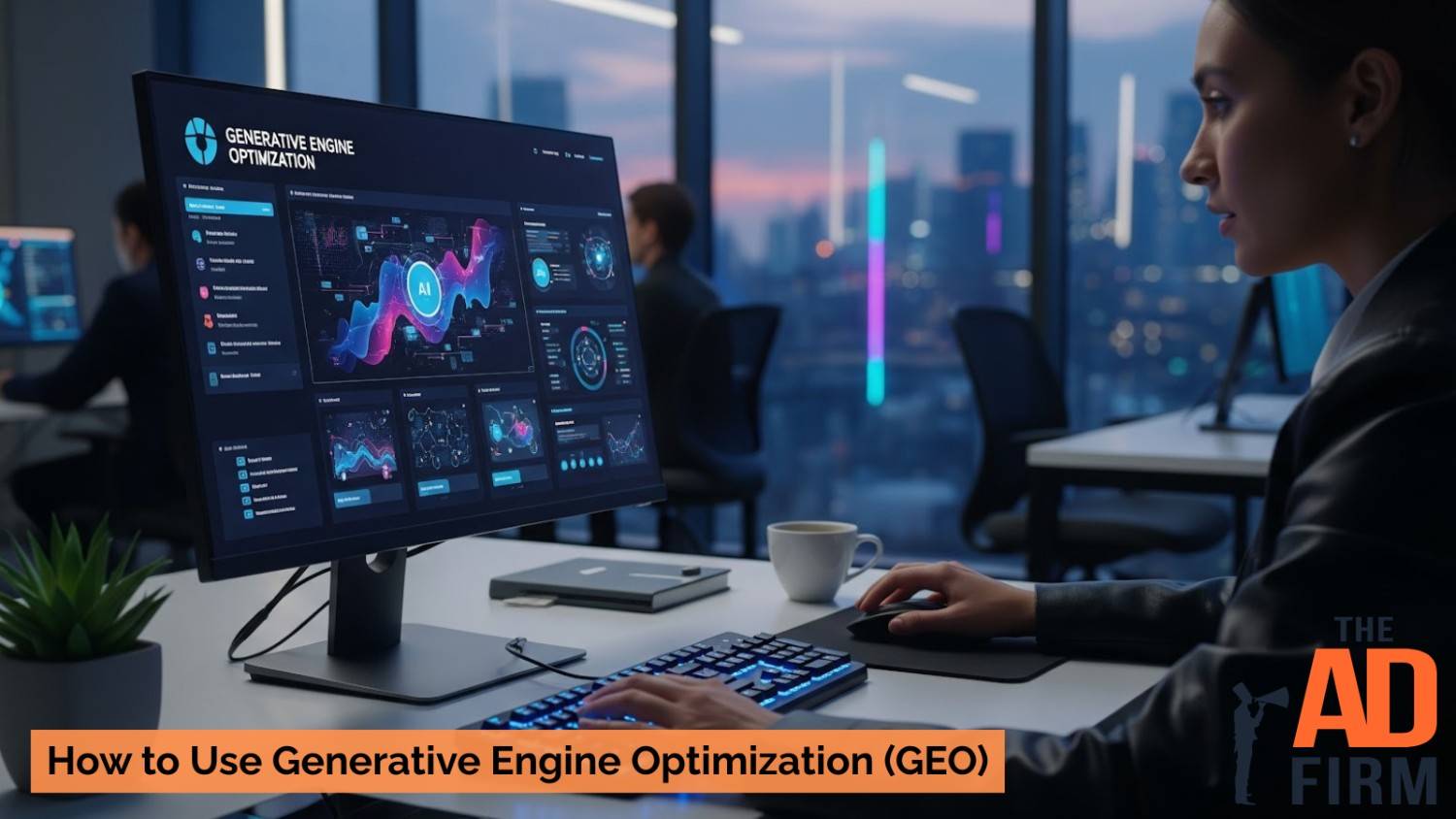AI-powered search is reshaping how people find information online. Instead of browsing through multiple websites, users now get instant, AI-generated summaries directly on the results page. This shift means brands must adapt their strategy to stay visible when AI summarizes answers for users.
That’s where Generative Engine Optimization comes in, a modern approach to making your content easy for these platforms to interpret, trust, and include in their summaries.
In this blog, you’ll learn practical, easy-to-follow ways to make your content more AI-friendly. We’ll walk you through how to plan, write, and optimize for AI-driven visibility, even if you’re not a technical marketer.
What Generative Engine Optimization (GEO) Actually Means
Generative Engine Optimization (GEO) ensures your website is structured and written in ways that AI engines can easily interpret and assess for credibility. Instead of optimizing purely for Google’s search rankings, you’re optimizing so AI tools like ChatGPT, Google’s AI Overviews, or Bing Copilot can confidently draw information from your content when generating responses.
GEO differs from traditional SEO because visibility doesn’t depend solely on clicks. Even if users don’t visit your website, AI can still mention your business or cite your content as a trusted source. This builds authority and exposure in the new world of AI-driven search.
The main goal of GEO is to make sure your expertise consistently informs AI-generated answers on topics within your industry. By improving your structure, clarity, and credibility, you increase the chances of being recognized as a reliable source, giving your brand more visibility even beyond standard search results.
Read Also: How to Implement Generative Engine Optimization (GEO) Strategies
Step 1: Research and Strategy: Understand What AI Prioritizes
Before creating content, it’s essential to understand what generative engines actually value. This means looking beyond keywords and learning how AI interprets intent, context, and authority to decide which brands to mention in its answers.
- Research conversational queries: Start by identifying the types of questions people naturally ask in AI tools or voice search, like “how does local SEO work” or “best web design company near me.” These are conversational, real-world searches that reflect how users speak to AI. By mapping these questions, you can build content that directly addresses how people phrase their problems, thereby increasing your visibility in AI-generated responses.
- Study AI overviews and competitor mentions: Open Google’s AI Overviews or Bing’s Copilot results for your target topics. Notice which websites or brands the AI repeatedly cites and the tone they use; are they conversational, data-driven, or instructional? This tells you what kind of structure and authority signals AI prefers, helping you shape your own approach.
- Build topic clusters, not just keyword lists: Instead of focusing on single keywords, group related topics into a single theme. For example, instead of only writing about “SEO audits,” you can create a content cluster that covers “how audits improve visibility,” “common audit mistakes,” and “how AI measures site quality.” This interconnected approach enables AI to recognize your expertise as comprehensive and trustworthy.
- Understand user intent: Every query has a goal; some users want quick definitions, while others seek step-by-step guides or product comparisons. Before writing, identify what the audience expects to learn from each query. This ensures your content fully answers their needs, positioning your brand as a helpful and reliable SEO company in the process.
Step 2: Create GEO-Friendly Content
Once you know what AI prioritizes, the next step is creating content that’s easy for both people and AI to understand. The goal is to communicate clearly, build trust, and make your expertise accessible in a format AI platforms can easily extract.
Enhance Your Brand Visibility with The Ad Firm
- SEO: Enhance your online presence with our advanced SEO tactics designed for long-term success.
- Content Marketing: Tell your brand’s story through compelling content that engages and retains customers.
- Web Design: Design visually appealing and user-friendly websites that stand out in your industry.
- Answer questions directly: Begin each section or paragraph with a short, straightforward answer to the user’s main question before expanding. AI tools prioritize straightforward explanations because they can summarize them easily for readers. This approach also helps people quickly find the information they’re looking for, improving engagement and trust.
- Use simple, structured formatting: Break content into short paragraphs and bullet points, and use subheadings that sound like questions users might ask. This structure guides both humans and AI through your content smoothly, increasing readability. When your formatting is predictable and easy to scan, AI can pull accurate snippets from it more confidently.
- Incorporate real experience (E-E-A-T): E-E-A-T stands for Experience, Expertise, Authoritativeness, and Trustworthiness. To show this, include examples from client projects, case studies, or firsthand insights. Adding real outcomes or data points makes your content more credible, not just for readers but for AI models trained to identify trustworthy sources.
- Keep readability high: Avoid keyword stuffing or overly technical phrasing. Write as if you’re explaining a concept to someone new to SEO, using plain language and natural flow. AI systems favor this conversational tone because it aligns with how they deliver answers to users.
- Support answers with context: AI systems value content that feels complete and factual. Add brief examples, statistics, or analogies that reinforce your point. For instance, you might explain how improving meta descriptions boosted clicks by 15%; that small detail signals reliability and depth to AI tools.
Step 3: Strengthen Technical and Authority Signals
After creating content, your next focus should be strengthening the technical and authority signals that help AI systems recognize your site as dependable and well-optimized. This is where technical optimization and brand authority come together to support long-term visibility.
- Ensure your site is crawlable: AI systems rely on the same foundational web signals as search engines. If your site loads slowly, isn’t mobile-friendly, or blocks indexing, AI may not be able to access your pages. Ensure your technical setup is clean, fast, and optimized to keep your information visible to both users and AI-driven platforms.
- Use schema markup effectively: Schema markup (structured data) is a type of code that helps AI understand the meaning of your content. Adding schema, such as FAQPage, HowTo, or Article tags, makes it easier for AI tools to detect what each page is about and how it connects to other pages. This is especially useful for a digital marketing agency trying to rank for detailed guides or service explanations.
- Build high-quality backlinks and mentions: Collaborate with credible websites, share expert insights, or contribute to trusted publications. These backlinks serve as digital “votes of confidence” that AI interprets as proof of authority. The more reputable your mentions are, the more likely your brand will be referenced in AI-generated answers.
- Maintain consistent branding: Ensure your business name, address, and links are consistent across your website, social media, and directory listings. Consistency signals reliability and makes AI more likely to connect your content to your brand identity. This is crucial for businesses managing multiple locations or service areas, such as those specializing in ecommerce SEO.
Step 4: Track Performance and Adjust for AI Visibility
Even the best GEO strategy needs fine-tuning. Tracking your performance helps you understand how well your content performs in AI-driven search and where you can improve to stay ahead.
Advance Your Digital Reach with The Ad Firm
- Local SEO: Dominate your local market and attract more customers with targeted local SEO strategies.
- PPC: Use precise PPC management to draw high-quality traffic and boost your leads effectively.
- Content Marketing: Create and distribute valuable, relevant content that captivates your audience and builds authority.
- Monitor brand mentions: Use tools that show where your business appears in AI-generated results like Google’s AI Overviews or ChatGPT responses. This helps you see not only if your brand is being mentioned but also how accurately your information is represented. If AI misquotes or overlooks your content, it’s a signal that your structure or authority needs strengthening.
- Measure engagement shifts: Review your analytics for changes in organic traffic, click-through rates, or time spent on key pages. Sometimes visibility improves in AI results even if traffic appears stable, so look deeper into user behavior. More extended visits or higher interaction rates often mean users trust your brand more after seeing it referenced by AI.
- Refine based on data: Pay attention to which content formats, guides, FAQs, or comparisons get cited most often by AI tools. Then replicate those successful patterns across new pages to maintain consistency. Adjust weak areas by adding clarity, evidence, or structure so your information continues to meet AI’s evolving quality signals.
- Stay adaptable: AI systems update frequently, and what works today might shift in a few months. Review your GEO-focused content quarterly to ensure it aligns with the latest search trends. Staying proactive ensures your brand continues to appear in relevant AI responses, rather than losing visibility to competitors who evolve more quickly.
Partner With The Ad Firm to Future-Proof Your SEO
Generative Engine Optimization (GEO) is no longer optional; it’s the bridge between your brand and how modern AI systems deliver answers. The sooner your business adapts, the sooner you’ll gain visibility in this new AI-driven search environment.
At The Ad Firm, our team combines traditional SEO expertise with AI-powered strategies that make your content more accessible to both humans and AI, enabling it to be found and trusted more easily.
We focus on transparent reporting, real performance tracking, and custom strategies tailored to your business goals. Whether you’re managing a local service brand or scaling multiple locations, we ensure every piece of content is optimized to appear in AI summaries and answer engines.
If you’re ready to stay ahead of competitors and make your brand visible in the future of search, contact The Ad Firm today to start building your GEO strategy.
Maximize Your Online Impact with The Ad Firm
- Local SEO: Capture the local market with strategic SEO techniques that drive foot traffic and online sales.
- Digital PR: Boost your brand’s image with strategic digital PR that connects and resonates with your audience.
- PPC: Implement targeted PPC campaigns that effectively convert interest into action.





